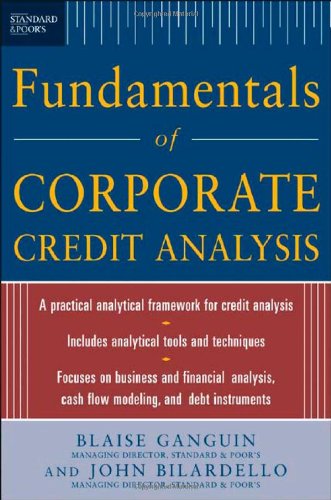Standard & Poor's Fundamentals of Corporate Credit Analysis epub
Par bennett kathy le vendredi, août 5 2016, 23:58 - Lien permanent
Standard & Poor's Fundamentals of Corporate Credit Analysis by Blaise, Ganguin


Standard & Poor's Fundamentals of Corporate Credit Analysis Blaise, Ganguin ebook
Publisher: McGraw-Hill
ISBN: 0071454586,
Page: 463
Format: pdf
The outlook on the company is negative. Telyukova, analyzes reverse mortgages. (S&P) provides credit ratings, indices, investment research, risk evaluation and data for investors. And it certainly pays for large corporations to employ teams of lawyers to find ways to minimize their global profit tax liabilities. �More than two years after the beginning of the recent crisis, U.S. Standard & Poor's Equity Research offers fundamental coverage on over 2,000 stocks. S&P, meanwhile, has bumped Sino-Forest's corporate credit rating and issue rating on its senior unsecured notes to CCC- from B. Credit rating agency Standard & Poor's downgraded Hewlett-Packard's credit rating earlier this week, citing poor policies, a high turnover rate among top executives and an unclear strategy. Although not a downgrade, it is a shock for an emerging market leader whose economic fundamentals have been improving so consistently in recent years that the upward trend was almost taken for granted. The most A Philly Fed Working Paper entitled Reverse Mortgage Loans: A Quantitative Analysis by Makoto Nakajima and Irina A. The corporation analyzes issuers and debt obligations of corporations, states and municipalities, financial According to the lawsuit, an unidentified S&P analyst, listed in the complaint as "Analyst D", wrote a parody of the song and emailed it to friends. Nevertheless, we see that the troughs in the monthly net credit balance preceded peaks in the monthly S&P 500 closes by six months in 2000 and four months in 2007. �We have concerns that HP's inconsistent growth strategies and high levels of board of director and senior management turnover have elevated the level of operational and execution risk in the near term,” S&P analyst Martha Toll Reed said in a statement. In July of 2001, S&P published a public bond default study which found that public bonds default at much lower rates than corporate bonds of similar or higher credit ratings.